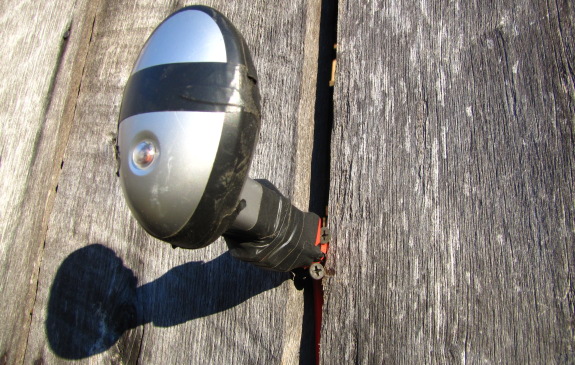
Do it yourself L.E.D. deer deterrent

I've been experimenting
with one of these L.E.D. night lights to see if it can function as a
low budget deer deterrent that shows motion during vulnerable night
hours.
It only took a few minutes to
wrap electrical tape around the cracks to make it water proof and
mounting was even easier as shown in the image above.
A little sensor knows when
the sun goes down and begins projecting different colored light
patterns on the side of the barn, which will hopefully appear as
human/hunter movement to any potential night nibblers.
Want more in-depth information? Browse through our books.
Or explore more posts by date or by subject.
About us: Anna Hess and Mark Hamilton spent over a decade living self-sufficiently in the mountains of Virginia before moving north to start over from scratch in the foothills of Ohio. They've experimented with permaculture, no-till gardening, trailersteading, home-based microbusinesses and much more, writing about their adventures in both blogs and books.
Want to be notified when new comments are posted on this page? Click on the RSS button after you add a comment to subscribe to the comment feed, or simply check the box beside "email replies to me" while writing your comment.

My memory of the distinction (from my animal behavior class, I think?) is that animals see color if they need to see colorful objects, like flowers' or ripening fruit, or the colorful plumage of certain species. So, diurnal animals that don't need to see those things probably would be color blind (say, a cow.)
On the other hand, I think there are also many degrees of color blind. For example, birds and bees would say that we're color blind since we can't see UV. A quick search of the internet turns up the potential factoid that deer can see yellows and greens. That's confirmed by Wikipedia, who says:
"Eutherian mammals other than primates (for example, dogs, cats, mammalian farm animals) generally have less-effective two-receptor (dichromatic) color perception systems, which distinguish blue, green, and yellow—but cannot distinguish reds. The adaptation to see reds is particularly important for primate mammals, since it leads to identification of fruits, and also newly sprouting leaves, which are particularly nutritious."